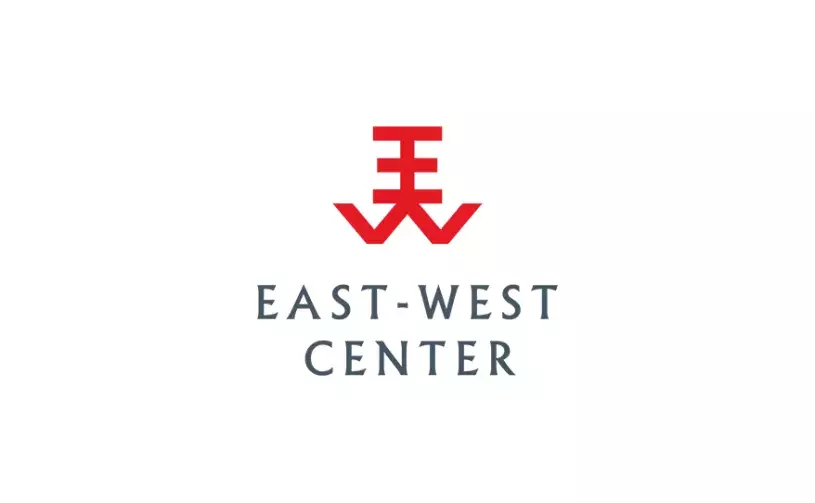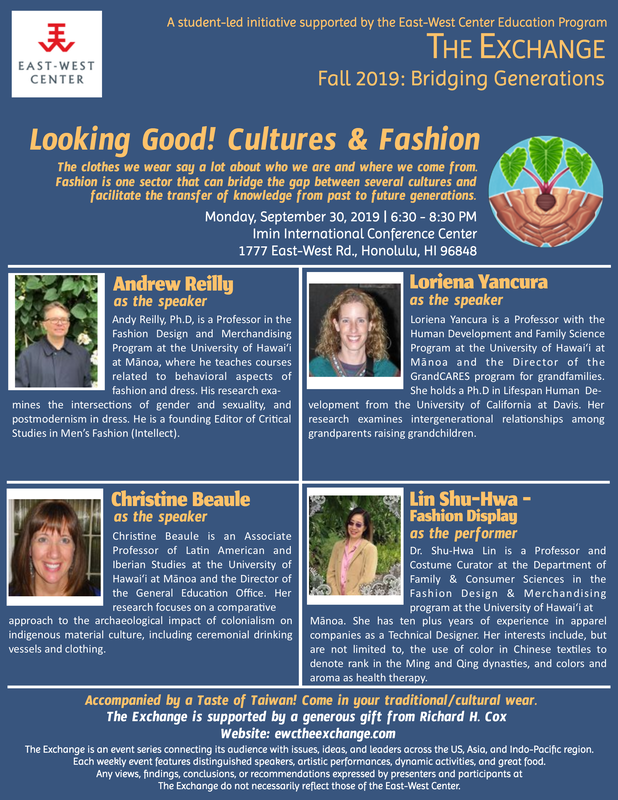Error message

OFFICE/DEPARTMENT

Description:
The clothes we wear say a lot about who we are and where we come from. Fashion is one form of cultural expression. Each culture has its own hues and specialties. One can become a part of another’s culture, tradition, and heritage, by integrating one or many fashion elements. In this way, we can bring about a union of many cultures, with fashion as the much-needed strong foundation. Fashion is one sector that can bridge the gap between several cultures. Cultural expressions facilitate the transfer of knowledge from past to future generations. This session explores different clothing through the ages in the Asia Pacific region.
Goals and Objectives:
Learn how fashion changed over time through trends and comebacks
Examine how fashion can bridge gaps in understanding cultures and generations
Explore the different fashion outfits of the Asia Pacific region
Presenter 1: Andrew Reilly
Andy Reilly, PhD, is Professor in the Fashion Design and Merchandising Program at the University of Hawai‘i, Mānoa, where he teaches courses related to behavioral aspects of fashion and dress. His research examines the intersections of gender and sexuality, and post- postmodernism in dress. His books include The Men’s Fashion Reader (2008), Meanings of Dress 3 rd and 4 th editions (2012), Crossing Gender Boundaries (2019), Introducing Fashion Theory (2020), and Fashion, Dress, and Post-postmodernism (2020, forthcoming). He is a founding Editor of Critical Studies in Men’s Fashion (Intellect).
Presenter 2: Loriena Yancura
Loriena Yancura is a Professor with the Human Development and Family Science Program. She holds a Ph.D. in lifespan Human Development from the University of California at Davis. Her research examines intergenerational relationships among grandparents raising grandchildren. She is currently the director of the GrandCARES program for grandfamilies.
Presenter 3: Christine Beaule
Christine Beaule is an Associate Professor of Latin American and Iberian Studies at UH Mānoa, and the Director of the General Education Office. Her research focuses on a comparative approach to the archaeological impact of colonialism on indigenous material culture, including ceremonial drinking vessels and clothing. Her recent work on clothing uses Aymara and Quechua men and women’s everyday dress and festival costumes to trace sociopolitical changes in Andean (Peru and Bolivia) indigenous identity from the Inka through today.
Performer: Lin Shu-Hwa - Fashion Display
Dr. Shu-Hwa Lin is a Professor and Costume Curator at the Department of Family & Consumer Sciences in the Fashion Design & Merchandising Program at the University of Hawai ̒i at Mānoa. She conducted experiments with vegetable dyes on natural fibers and conducted the effect vegetable dyes’ color on influences of pH scale. Specially, she is interested on coffee dyes and attempted to preserve the coffee aroma as well. Also, Dr. Lin likes colors and aroma as health therapy aspects in her research. For thirteen years Dr. Lin worked in apparel companies as a Technical designer in charge of patterns and production management. She is especially interested in Chinese textiles in the Ming and Qing dynasty, specially the uses of color as ranks.

Description:
The clothes we wear say a lot about who we are and where we come from. Fashion is one form of cultural expression. Each culture has its own hues and specialties. One can become a part of another’s culture, tradition, and heritage, by integrating one or many fashion elements. In this way, we can bring about a union of many cultures, with fashion as the much-needed strong foundation. Fashion is one sector that can bridge the gap between several cultures. Cultural expressions facilitate the transfer of knowledge from past to future generations. This session explores different clothing through the ages in the Asia Pacific region.
Goals and Objectives:
Learn how fashion changed over time through trends and comebacks
Examine how fashion can bridge gaps in understanding cultures and generations
Explore the different fashion outfits of the Asia Pacific region
Presenter 1: Andrew Reilly
Andy Reilly, PhD, is Professor in the Fashion Design and Merchandising Program at the University of Hawai‘i, Mānoa, where he teaches courses related to behavioral aspects of fashion and dress. His research examines the intersections of gender and sexuality, and post- postmodernism in dress. His books include The Men’s Fashion Reader (2008), Meanings of Dress 3 rd and 4 th editions (2012), Crossing Gender Boundaries (2019), Introducing Fashion Theory (2020), and Fashion, Dress, and Post-postmodernism (2020, forthcoming). He is a founding Editor of Critical Studies in Men’s Fashion (Intellect).
Presenter 2: Loriena Yancura
Loriena Yancura is a Professor with the Human Development and Family Science Program. She holds a Ph.D. in lifespan Human Development from the University of California at Davis. Her research examines intergenerational relationships among grandparents raising grandchildren. She is currently the director of the GrandCARES program for grandfamilies.
Presenter 3: Christine Beaule
Christine Beaule is an Associate Professor of Latin American and Iberian Studies at UH Mānoa, and the Director of the General Education Office. Her research focuses on a comparative approach to the archaeological impact of colonialism on indigenous material culture, including ceremonial drinking vessels and clothing. Her recent work on clothing uses Aymara and Quechua men and women’s everyday dress and festival costumes to trace sociopolitical changes in Andean (Peru and Bolivia) indigenous identity from the Inka through today.
Performer: Lin Shu-Hwa - Fashion Display
Dr. Shu-Hwa Lin is a Professor and Costume Curator at the Department of Family & Consumer Sciences in the Fashion Design & Merchandising Program at the University of Hawai ̒i at Mānoa. She conducted experiments with vegetable dyes on natural fibers and conducted the effect vegetable dyes’ color on influences of pH scale. Specially, she is interested on coffee dyes and attempted to preserve the coffee aroma as well. Also, Dr. Lin likes colors and aroma as health therapy aspects in her research. For thirteen years Dr. Lin worked in apparel companies as a Technical designer in charge of patterns and production management. She is especially interested in Chinese textiles in the Ming and Qing dynasty, specially the uses of color as ranks.






